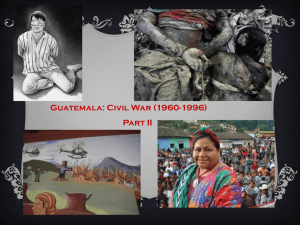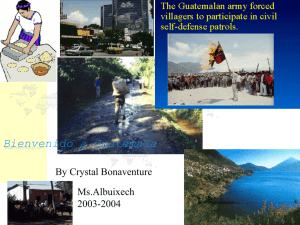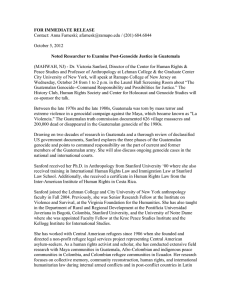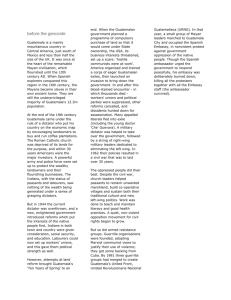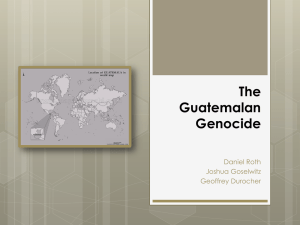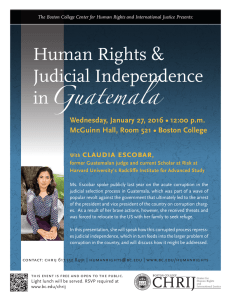Document 14256289
advertisement
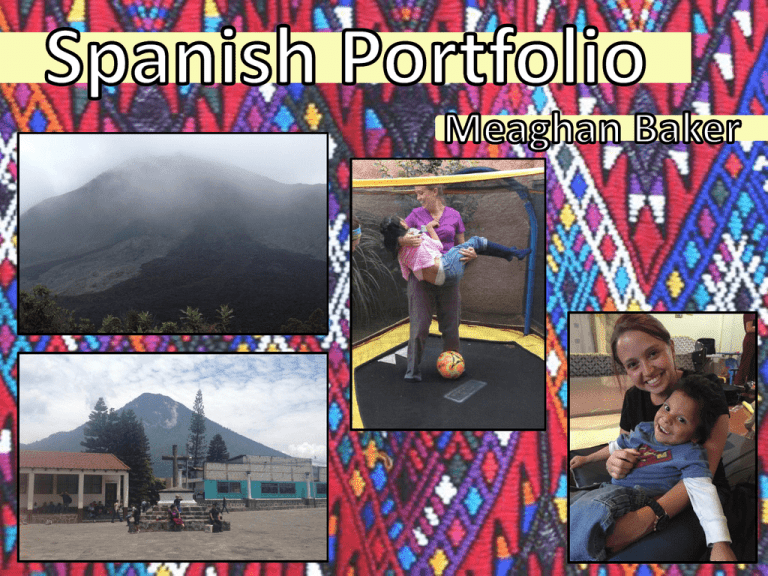
Lago Atitlán El Volcán El Lago Los Barcos El Día De Excursión Al Lago Sunday, May 31, 2015 was our first excursion day. We began the day with a 3 hour bus ride through Zaragoza and Patzún, and stopped at a restaurant called Hacienda Tecpan on the way to Lago Atitlán. Driving through Zaragoza and Patzún was very interesting since we had read about them in the book, To the Mountain and Back, by Jody Glittenberg. I noticed in Zaragoza that the streets were mostly straight, many individuals looked Caucasian, and most people were wearing black or dark huipiles and outfits. In Patzún I observed the more curvy streets, very colorful huipiles and outfits, and women carrying children on their backs. It was very clear that the descriptions Glittenberg (1994) wrote about in her book were very correct. Benz (1996) also mentioned in Guatemalan Journey that the road from Antigua to the lake was full of sharp curves and steep hills, which I learned was very true. I had the opportunity to take part in some Guatemalan culture at Hacienda Tecpan through eating very traditional food and making tortillas. The food was delicious; we had la sandia, la piña, los huevos, los frijoles, los plátanos, los tamales, y el queso. I learned to say buen provecho (enjoy your meal) and yo quiero comer (I want to eat). Learning to make tortillas was also really interesting because I learned how difficult it is. I also had the chance to immerse myself in more Guatemalan culture when I bargained for the first time while buying a blanket at a lakeside market. It was much different from shopping in the U.S., but it was a really good experience and I got to use some of my Spanish. After making a stop for breakfast and travelling through Zaragoza and Patzún, we finally made it to Lake Atitlán. As soon as I stepped off the bus I was taken aback by how beautiful it was. There were a few markets leading up to the lake and 2 boats waiting for us. I was surprised to learn from Steve that the buoyancy and density of the water is much different because of the altitude, which makes things sink a lot faster than we are used to in the U.S. I was also surprised at how long it took us to cross the lake because at first glance it did not look like we were very far from the volcanoes on the opposite side. I chose this picture because the lake was the main focus of our first excursion day, we learned a lot about it from the student presentation, and it was how we got to a cathedral and the Peace Park on the opposite side. I learned from the student presentation that water contamination is a major problem at this lake. The contamination is mainly due to pollution from tourists and raw sewage. Access to clean water is a major, social issue in Guatemala. I also saw as we were driving around the lake that Guatemalans use this lake as a place to wash their clothes. Once we crossed the lake we visited the cathedral where Father Stanley Rother was murdered. This was very interesting to see his belongings, the room he was killed in, and the memorial the Guatemalan people have created for him. The culture inside the cathedral was also very interesting – we saw the statues that different families pay to dress which was mentioned in Glittenberg’s (1994) book. We also visited the Peace Park and learned first-hand about how the civil war affected the Guatemalan people. While at the Peace Park, I also learned from Steve about a mud slide that wiped out the surrounding community. It was interesting to learn that people will not build around this area because they think it is disrespectful to individuals who died there. Hogar De La Esperanza Alcanza Mi Amiga Terapista Ocupacional El Día De Servicio Hogar De La Esperanza I consider myself lucky to have had the opportunity to complete my service work at Hogar De La Esperanza, or Hope for Home Ministries, in Guatemala. Guatemalans call orphanages hogares, which is Spanish for home. This orphanage embodied the name “home” in every sense of the word. Daryl and Wanda Fulp own and run the home which includes 12-13 orphans with disabilites, and 7 of their own children; although, they consider them all their own children. Personally, I found their viewpoints amazing because after reading Living with Disability in Guatemala by Couch, Goetz, and Baud (1991), I expected much different. In this article the authors discuss how Guatemalans view individuals with disabilities as charity cases and they prefer normal people. The goal of this home is to help the children and their families eventually live together again. For some this is not an option, and the Fulps are happy to keep them for as long as necessary. Before leaving for Guatemala I learned a lot about Guatemalan orphanages or hogares because this was my Spanish presentation. I learned that international adoptions with Guatemala were closed in 2008 because of corruption. Adoptions were very expensive, which made it nearly impossible for other Guatemalans to adopt, and it became a business to have children and adopt them out to other countries. Many children were also being kidnapped to be placed with a foreign, adoptive family. This became a major social issue because many foreigners thought they were doing good by adopting Guatemalan children, but in reality they may not have been adopting real orphans. It is also a major issue for Guatemalans who would like to adopt in-country, but cannot due to the cost. International adoptions are still closed in order to reform the Guatemalan adoption process. My time at Hogar De La Esperanza taught me a lot about how orphanages/homes work in Guatemala, but I also learned more about occupational therapy than I have in my schooling thus far. I learned from talking with Daryl Fulp that opening a hogar in Guatemala is not an easy process, and he had to gain the trust of many people to acquire the status his ministry has today. In addition, to be able to bring a new child into his home requires many meetings with the Guatemalan court system. I also learned from talking to Wanda Fulp about the culture difficulties they faced when they first moved to Guatemala. One specific example I learned was that it is normal in Guatemalan culture to give babies coffee in their bottles. A nanny the Fulps hired tried to do this and was shocked when Wanda told her that people in the States do not have coffee until their late teens. This showed me how important coffee is in the Guatemalan culture. I chose this picture of Alejandra, one of the children at Hogar De La Esperanza, because she was one of my favorite children to work with. Alejandra was in a power chair and non-verbal, but could understand Spanish and some English, and was brilliant. In the picture we were able to get her out of her wheelchair and in a standing position, which is something she loved and does not get to do very often. After spending two days here I worked with almost all the children and learned so much about how to be an occupational therapist. The practitioners taught me many helpful activities to do with children with disabilities, and I became much more confident with my OT skills. Doing this work made me feel more like a sojourner because I was affecting my new environment in more ways than a tourist would. I also became more confident with my Spanish skills. I found myself using many of the sayings we learned in Spanish 258 such as: no muerdas, camina, toca, sopla las burbujas, and many more. I learned how to say bien portado (be nice). When we left the Fulp’s home I was almost brought to tears by the memories of all I experienced while there, and Daryl said a beautiful prayer for us before hugging each of us goodbye. La Vega Escuela Huipile Corte Los Estudiantes El Día De Excursión La Vega Escuela On our fifth day in Guatemala we traveled to a school called La Vega in Patzún. I learned that all the students are able to attend school because of scholarships, and many of them have to walk many miles to and from school. I quickly realized this is a main social issue in Guatemala because, unlike in the U.S. where school is required by law and free, children have to pay to go to school. Most cannot afford to attend school or give up time working for their family. The children at La Vega had greatly prepared for our visit with plays, music presentations, and classroom presentations. One of the first things they did for us was present a few short plays that represented their culture. One major aspect I noticed in each was that women were not respected as much as men. For example, the boys beat the girls at times, and in a skit about marriage it was shown that the woman does not have much of a choice in whom she marries. I was saddened by this because this is what many Guatemalan children are taught. This is much different from what I have learned growing up, and I believe this will affect the way these children will act when they are older. I chose this picture because it has a great view of the sawdust rug, the classroom set up, and the cultural dress on the walls. The children had smaller presentations prepared in the classrooms for us, and I learned a lot about their culture from these. Each room had a rug made out of sawdust that they told us are used for celebrations . They each had special meanings behind their designs, and I found them to be very interesting. The set up of each classroom was very simple—a small amount of desks and chairs organized in a circle. On the walls of each classroom were examples of different huipiles and cortes that are common in Guatemalan culture. They told us that each fabric was specific to the area that it was created in and intended for. I found the combinations of many colors to be beautiful. One interesting thing I learned in the students’ presentations was that the word Patzún means the land of sunflowers, which explained the sunflower decorations throughout the school. I did not have to use much of my Spanish because most of the children spoke English, Spanish, and the indigenous langauge spoken in Patzún called Kaqchikel. They also taught us a few words in Kaqchikel; the only one I was able to remember was mez, which means cat. I learned from the children’s presentation in the classroom that la pedida means the request or proposal. Las Ruinas Mayas Los Árboles El Día De Excursión Las Ruinas Mayas After visiting La Vega, our group drove to a Mayan Ruins site. By the time we arrived it was around lunch time and we were all starving, so we decided to eat first. While in Guatemala I saw an extremely large amount of stray dogs, which made me very sad, and there were a couple at the ruins that day. One watched us eat the whole time, so we named her Socks and fed her, even though it had been “suggested” that we not. After lunch we made our way over to the ruins to meet our 2 tour guides. Before leaving for Guatemala, two of my classmates gave a presentation about the Mayan Ruins and I learned quite a bit before going there. They taught me that there are 3 main plazas of the ruins, but 1 is separated by a stone wall. There is a middle area that is used for ceremonies, and it was once separated by a creek that separated it from the common people. I also learned that there are 2 ball courts that were once used for ceremonial games where someone would be sacrificed at the end. This information was very helpful to know before going into the actual ruins, which were filled with culture and heritage of the Guatemalan people. I chose this picture because I found this structure to be very fascinating to look at, and I thought it was interesting that there was a tree growing from the inside. I don’t know why I did not expect to see that, but it makes sense since the structures have been sitting and breaking down for many years. During the tour of the Mayan Ruins I learned a lot more about them than I had previously known. The tour guide told us many tales about the origins of the structures, most of which I cannot remember completely. One I partly remember was about a princess sitting at the ball game court who spoke to the leaves on the trees surrounding her. I also learned that some of the balls used in the ball court games contained human skulls. Darvy was joking with me at the ball court and taught me here that baloncesto means basketball in Spanish. During our visit I also found it very interesting that we could still see paintings created by the Mayans on some of the structures. They were many different colors and it was difficult to make out exactly what they were, but they were still beautiful. Our tour guide also informed us that only 4 families lived in the ruins. I found this to be odd because they were huge, but families were probably much larger then than they are now. We were also told that many of the public structures were built higher up so that upper class individuals could see inside, but common people were stuck outside. I really enjoyed learning about these historic structures, and it made me wish that we did not tear buildings down so quickly in the U.S. so that we could preserve more of our history. Here, I felt completely like a tourist and not a sojourner. I was not making a difference whatsoever because this excursion was purely for pleasure and learning. Our group may have even done some damage if we left any trash behind after our picnic lunch outside the ruins. Misioneras de la Carretera Agarra La Pelota Madre El Día De Servicio Misioneras de la Carretera On our third service day in Guatemala, my group was unable to go back to Hogar De La Esperanza so we joined one of the other groups at Misioneras de la Carretera (Missionaries of the Highway). As soon as we arrived, we realized this was a much different environment than at the Fulp’s home. We unfortunately got there about 20 minutes late, and were surprised to see clients already waiting for us. My group did not know much about this service site, but quickly gathered that it has a school and some living facilities, but also offers outpatient therapy. It was also a much more fast-paced environment than we were used to at the Fulp’s home. My small group saw 8 patients for 45 minutes each. In addition, today was when my Spanish language knowledge was tested the most. All of the children did not know English, and their families did not either. I found myself learning quickly from Giovanni, our interpreter, and Maddy, a fellow student. Two new phrases I learned were buen trabajo (good work/job) and dame cinco (give me five). I once again felt more like a sojourner here because I was able to help the Guatemalan people. Being able to see the facility was great, but I was not there just to look. I was there to give what little OT skills I have, and learn from the clients that came for our help. The reason I chose this picture was because you can clearly see the child working very hard in his therapy, and his mother is watching closely in the background. Throughout the various children we worked with on this day, one thing that really stood out to me was how much their families seemed to care about their therapy. There was a waiting area at the front of the facility, but all the family members stayed in the room and watched what we did. They all seemed very receptive and appeared to want the best for their children. This was very interesting to me because I believe it says a lot about the Guatemalan culture and how important family is to them. As I learned in the Living with Disability in Guatemala, most Guatemalans with disabilities live and depend on their families for care (Couch, Goetz, and Baud, 1991). This is seen in the U.S., but I believe we have a greater push for independence. Most family members were also wearing traditional dress, which was another cultural experience for me. Another social issue that became apparent to me while at the center was that many families had to travel numerous miles and hours for a short therapy session. Occupational therapy is very important and much needed for the Guatemalan people, but it could be helping a greater number of individuals if it was more readily available. There are not enough therapists in Guatemala and because of this, some families do not understand its importance. Hogar Amor Del Niño La Tia El Grupo Los Niños El Día De Excursión Hogar Amor Del Niño Throughout the week, we were working with Steve Osborn and hearing about the orphanage he and his wife run called Amor Del Niño, which means love the child. On our seventh day in Guatemala we finally got to visit their hogar. Due to major traffic jams resulting from political rallies, it took us about 3 hours to get to Amor Del Niño. I noticed a huge cultural difference here because the Guatemalans with us were much less annoyed by our lateness than we are. Time did not seem to matter in Guatemalan culture, similar to what Benz (1996) said in Guatemalan Journey that Central Americans do not hurry. I did learn during the drive that pinchazo means flat tire and parqueo means parking. Once we finally arrived, I was amazed by the facility that the Osborns were running. Their dining room was filled with nearly 15 high chairs, a long table with bench seats, and a table with about 10 built-in seats for young children. As I walked through the house, I noticed they had roughly 40 children “organized” from youngest to oldest. There was also a great amount of staff available to help Steve’s wife Shyrel. Since we did not arrive on time, we were unable to help the children with therapy needs, so we all took turns playing with the different age groups. I chose this picture because I really enjoyed playing with these babies. I also like that this picture shows how the children were dressed. I learned that it is common in Guatemalan culture to dress babies and young children in many layers, even if it is hot. Most of the children were sweating due to this, and I was very surprised that no one thought to take some layers off of them. While everyone was playing with the children, I had the chance to speak briefly with Shyrel. She told me about the corruptions in the Gautemalan court system, specifically considering adoptions. Shyrel informed me that it has taken her many years to build a rapport with the Guatemalan courts, but they now look to her when decisions need to be made considering orphans and adoptions. She also gave me the background information about the child I was holding at the time, and said that he was found in a trash can in Antigua. This broke my heart, but made it clear to me what great work the Osborn family is doing in Guatemala. I was very grateful to be able to visit this wonderful home. We all also had the chance to help feed the children dinner. The organization in the home was fantastic, but I could tell some of the care providers were not well-educated about childcare. When one girl who was around 10 months old was not eating, the care taker came over and started shoving the oatmeal in her mouth very quickly. After a very short amount of time the girl vomited everything she was fed. The social issue of education was clear in this moment because I realized the women working at Amor Del Niño most likely were not well-educated on how to take care of children. They were effective in their jobs, but there were many moments such as this one where I could tell they were not doing what was most helpful. El Volcán El Volcán Pacaya Estudiante De Terapia Ocupacional El Día De Excursión El Volcán On our last full day in Guatemala we woke up extremely early and hit the road by 6 am to climb Volcán Pacaya. As soon as we arrived, there were many men and children on horseback who wanted to sell us walking sticks and rides up the volcano. We were told to politely ignore them, and Rolando bought us all walking sticks. After a quick bathroom break and application of bug spray, we started our hike. I was not prepared for how difficult it was going to be. The first 15 minutes of our hike was very steep and slippery, but thank goodness it leveled out at some points and was not as slippery. Along the way and once we got to the top, the views were beautiful. After we took many pictures we began to climb into the volcano where volcanic rock surrounded us. That is shown in the picture I chose. I picked this photo because I think it gives a great view of what the inside of a volcano looks like, which is something I do not think many people get to experience. This was yet another aspect of my time in Gautemala that I was very thankful for, and that is why I love this picture. Once we were inside the volcano we found what most of us had been waiting for the entire trip—the volanic rock jewelry store. The men working inside were very kind and helpful, and I learned that it is all for a great cause. I bought a homemade ring and necklace that both contain volcanic rock. Once we descended the volcano there were many children asking us to buy them food. This was similar to what Benz (1996) described in Guatemalan Journey about the street children – they were around 9-10 years old, they tended to stay in small groups, and they seemed very poor. Before leaving for the trip, I was under the impression that our excursion to the volcano was solely for pleasure. To my surprise, there were many issues to learn about at our hike. The first is the various problems that Guatemalans have due to living near the numerous active volcanoes in the country. After talking to Darvy and Lisa, I learned that the last time a major volcano erupted the majority of the country was covered in thick, white ash for many weeks. This posed a major problem to famers in the area whose crops were covered in ash and most likely ruined, and most people did not have extra time in their day to spend constantly cleaning off the ash. An eruption could get in the way of many individual’s jobs and sources of income; which could be devastating in a culture where they work so hard for so little and it is very important to them. Another issue I found while climbing Volcán Pacaya was that many individuals made their homes along the side of it. These families seemed to be very poor, and after speaking to Darvy I learned that they live here because they cannot afford to live elsewhere. I think this is a major problem because of the dangers of living on something that could explode at any minute. I also did not realize the store at the top of the volcano was helping to fight social issues in Guatemala. The store is run by a group called Mayan Rebirth, and was started after the Pacaya Volcano erupted in 2010. They make all the jewelry they sell out of coconut shells and volcanic rock, and then donate some of their profits to Guatemalan social programs. One of the main organizations they help support is Habitat for Humanity in Guatemala. I found it wonderful that a group a people felt compelled to help after they saw how much damage a volcano eruption does to the Guatemalan communities. I really enjoyed hiking the volcano and learning so much about how the volcanoes are such a huge part of the lives of many Guatemalans. El Cementerio Amarillo Las Tumbas El Día De Excursión El Cementerio After climbing Volcán Pacaya, we drove to a local cemetery. I was in Rolando’s van and he taught us a lot about Guatemalan cemeteries and the social issues that lie within them. I did not know anything about them before the trip, so this was very interesting to me. Visiting the cemetery was one of my favorite parts of the trip because it was so different from what I am used to seeing. One of the first things I think we all noticed was that the graves were above ground. Rolando did not seem to know why this was a tradition, it was just what everyone did. I chose this picture because it shows the above ground graves, as well as the different types of graves. In the back of the photo there are filing cabinet style graves, which I learned are for individuals who are not very wealthy. Rolando told us that the families of the deceased are required to continue making payments on their loved one’s grave for many years after the burial. If families cannot pay the amount, the remains are taken out of the burial site and put into a mass grave. On the other hand, in the front of the photo are the larger, mausoleum style graves. These are owned by the wealthy and are usually paid in full, so no further payments need to be made; therefore, there is no risk of being put into a mass grave. I find this to be a huge social issue because I believe it is unfair to say that one person’s remains are worth more than another’s. Also, it is unjust to expect someone’s family to continue to pay for their grave after their death–eventually you would be paying for your ancestor’s burial sites. It is a huge injustice to respect the remains of one person over another’s solely based on the amount of money their family could afford at their time of death. Besides the main issue of purchasing graves in Guatemalan cemeteries, I learned much more about them. Rolando told us that his ministry uses the cemeteries as a way to help their troubled youth. They teach their children how to clean the grave sites, and then allow them to charge families for their work. I thought this was a great idea because it teaches the kids about hard work, and community members can benefit from this. I also learned that there are certain sections of the cemetery divided off for specific religions. We saw the section dedicated to people of the Jewish faith and it was very beautiful. Unfortunately, we also saw some graves that had been broken into. Rolando told us the story of a certain grave that was broken into and since thieves took the items the person was buried with, you could see their skeleton from the outside. Many of the grave sites were beautifully decorated with bright colors, flowers, religious symbols, and short sayings. I wish I understood more Spanish during this excursion because I would have loved to know what some of the graves said. We also passed a funeral and having a better understanding of Spanish would have allowed me to understand what they were saying. I did learn during our drive that disponible means available for rent. El Basurero Los Camiones El Día De Excursión El Basurero While we were driving through the cemetery, we stopped at an overlook to get a view of Guatemala’s largest dump, called El Basurero. Before leaving for the trip we listened to a student presentation on the dump and watched various videos about it. I learned from class that it is the size of 24 football fields and the location where 11,000 Guatemalan people. I chose this picture because you can see the true size of how enormous it really is. I also learned that there have been people working in the dump since the 1960’s, and after a large fire in 2005 there were many restrictions put on the workers. After the fire broke out, it was clear that it was not safe for children to be in. It is in a Guatemalan red zone and no place for a child to be working, so schools and day care facilities were built near the dump for parents to send their children to. It was also enforced that people could not continue to live in the dump. For many, El Basurero was their home and workplace, but after 2005 this was no longer allowed. Individuals were also required to acquire an I.D. badge that gained them entrance to the dump. Many were not happy with these changes, but they were for the safety of the Guatemalan people. Unfortunately, Steve was supposed to speak to us during our visit to the dump but had a flat tire and could not make it, so he told a few interesting details at dinner. He said the number of workers has dropped at the dump to about 4,000. I also learned that workers will pick through the trash for about 8 hours each day and make roughly $3-$4 American dollars. The actual experience of El Basurero was unlike any video we watched in class. The smell was overpowering and the vultures constantly flying overhead. It was a very humbling experience and I was thankful to be able to see it. The social issues within El Basurero are vast. One of the main problems is the view that others have of the dump workers. It is seen as an awful job and the workers are given as much respect as the trash they sort through. Most individuals who work there do not have any formal education, so they see this as a good source of income. Many families have generations working in the dump. I found it interesting the viewpoint we had on the dump—we were literally looking down on it and the people inside. That is another reason why I love this picture because I took others that were zoomed in and it appeared we were inside, but this showed the true irony. Another social issue that is prevalent at the dump is the large amount of gang activity. This has been improving since children are not allowed inside, but it is still common. It causes violence and territory issues within the dump, and there are not enough police or security forces to control it. While learning about the dump I learned that mala is Spanish for mean. At El Basurero I felt completely like a tourist, but I really wanted to feel more like a sojourner. The working conditions of the dump were deplorable, and I felt like I needed to do something more than just look down on them. Unfortunately, we did not have enough time left in our trip, and I’m not sure where one would even begin to change things for the workers. Entrevista Con Darvy Martin About The Stray Dog Population in Guatemala El Perro This was a stray dog that followed us during our hike up the volcano. We named her Sandy. On the way to Atitlán, I was fortunate to be able to sit with Darvy Matin on the bus. Darvy was one of our interpreters on the trip, and I loved talking with him. While we were on the bus for 3+ hours, I had the chance to ask him about the amount of stray dogs wandering the streets. This was something I was surprised to see because in the United States I am used to most stray dogs being kept in shelters, or people take them in. Darvy explained to me that the Guatemalan culture does not respect and like the dogs as we do. This is beginning to cause a major problem for Guatemala because the dogs are constantly reproducing and no one is taking them in. I also learned that most of the dogs have not received vaccinations, leaving them very risky for people to be in contact with. Darvy told me that the few who have been vaccinated were given red, plastic collars so that individuals would know. He also said that many people who buy puppies from the markets eventually have to let them go because they realize they cannot afford to feed them. Darvy then began to explain to me how much he cares about the dogs. He said most people do not try to stop if they are driving and a dog gets in the road, but he always makes an effort. One time he accidentally hit a dog, and he was very upset about it. Darvy also tries to save as many dogs as he can by taking them into his home. He will get them vaccinated, spayed or neutered, feed them, and try and find them permanent homes. I also learned from him that since the Guatemalan culture is not concerned with the stray dog population, not many people are willing to donate money to help him in his efforts. That is also the reason why there are not organizations to help homeless animals like we have in the U.S., such as The Humane Society. From my interview with Darvy Martin, I learned a lot about the stray dog population in Guatemala and how differently people in their culture view the animals. It made me sad to continuously see all the stray dogs, but as the week went on I noticed myself getting accustomed to seeing them and it did not bother me as much. Edward T. Hall’s Iceberg Model Common Humanity While in Guatemala I observed the many levels of Hall’s culture model: •Visible – the homemade tortillas we ate at Tecpan, the work ethic of the Guatemalan people, the Guatemalan markets I shopped at, the importance of coffee, and the cultural dress (huipiles and cortes). •Invisible – the Catholic religion I saw at the Cathedral, very family centered and focused as I saw with the people at Missionaries of the Highway and Daryl’s home, the role of women in Guatemalan society that I learned about at La Vega, and the very resilient attitudes of every Guatemalan individual I met. •Common Humanity – Guatemalans value hard work and I learned almost everyday that Guatemalan people value the time spent doing something rather than punctuality. References Benz, S. (1996). Guatemalan journey. Austin, Texas: University of Texas Press. Couch, R., Goetz, J., & Baud, H. (1991). Living with disability in Guatemala. Journal of Rehabilitation, 46-52. Glittenberg, J. (1994). To the mountain and back: The mysteries of Guatemalan highland family life. Prospect Heights, Ill.: Waveland Press. Information about the Edward T. Hall Iceberg Model and the sojourner vs. the tourist was taken from Spanish 258 class lecture. Information was taken from multiple student presentations during the Spanish 258 course. All background pictures were found on Google Images by searching for Guatemalan textiles. Cultural Iceberg picture was found on Google Images by searching for Edward T. Hall Iceberg Model.
